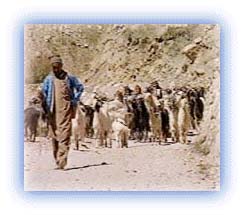Trekking
· General Info
· The Terrain
· Trekking Methods
· Preparations
· Physical Conditioning
· Acclimatization
· High Altitude Sickness
· Food and Water
· Exchange of Currency
· Trekking Permits

![]()
| Essential Prerequisites Trekking is a strenuous physical exercise and hence only those who are physically strong and in good condition should opt for this "sport". Trekking involves many stretches of ascents and descents. A day's walk of 10 to 15 kms can only be enjoyed by persons who are physically fit and have a special love for nature and the mountains. |
 |
| Aharbal, Kashmir Credit: KOA |
Before venturing out on a long trekking trip, one should mentally and physically prepare oneself. Regular physical exercise to remain in good condition is a must. by taking long walks. Similarly one should also develop a liking for out door living. One should be adaptable, accept variations and delays in schedule and be able to change plans if unusual situations develop.
One should be able to mix, interact and feel comfortable with the friendly hill people who are totally different in their approach to life. The interest in people will reduce the strenuous walks and physical exertion will not be felt. Westerners especially should make an effort to understand the level of economic development, and education of the people in the Himalayan regions. Large parts of the Himalayas have still not been exposed to so called modern living.
 |
| Balti herdsman with his flock at Kargil Credit: Karamjeet Singh |
Amenities like roads, electricity, telephones, are gradually being introduced into these areas, and may be unavailable in the remote areas. It is important to understand that the people in these regions have been nearly self sufficient for centuries, without these modern amenities. Hence if trekkers go with pre-conceived notions, then they will certainly be disappointed in not finding the ordinary day to day necessities, especially as one ventures into the remote areas.
For long treks, it is always advisable that people should make use of local shelters, in order to make trekking cheap and comfortable, rather than use the luxurious trekking facilities like mobile hotels arranged by the trekking agencies, unless that is exactly what the trekker wants.
All rights reserved